Seneca Park was named for the street that became Mies van der Rohe Way in honor of the architect who lived on its northeast corner at Pearson Street. Seneca Street ran from East Walton Street south to Chicago Avenue, extending through the park grounds to create a western boundary for the Chicago Avenue Armory site. Mies van der Rohe Way now crosses at the foot of the west-facing Museum of Contemporary Art. Coincidentally, in keeping with Mies's "less is more" axiom, there are no buildings with a Mies van der Rohe Way address, they all face the perpendicular streets. |
 |
 By permission and courtesy of the Chicago Park District Special Collections. |
In the October 25, 1989 Chicago Tribune, John Teets reported on the opening of the Eli M. Schulman/Seneca Park reconstruction project and the $100,000. fundraising benefit: "It was a hundred-thousand-dollar night, in fact: That's what the party in the grand ballroom of the Ritz netted for the Eli M. Schulman Palyground/Seneca Park reconstruction project, which is turning the little plot of land between the Water Tower Pumping Station and the Chicago Avenue Armory into a slice of civilized heaven. It's a memorial to the late Eli (who ran the restaurant across from the park), spearheaded by his son and daughtier-in-law, Marc and Maureen Schulman." |
| More about Seneca Park from the Chicago Park District website: Located just west of Chicago's venerable pumping station, tiny Seneca Park provides a quiet oasis from bustling Michigan Avenue. The Chicago Park District leases the park property from the City of Chicago Water Fund. Decades ago, beginning in 1907, the eastern portion of the property was briefly considered part of nearby Lake Shore Playground, and developed as such by the Lincoln Park Commission. In 1915, the State of Illinois built an armory between Seneca and Lake Shore Parks, permanently separating the two. By 1950, the Department of Public Works was managing the city property as Seneca Park. The Chicago Park District began to lease the parkland from the city in 1959. Seneca Park features both a lawn with shaded walkways and a playlot. On the lawn sit two recent sculptures by nationally-recognized artists: Ben, a bronze horse by sculptor Debra Butterfield, and Farmer's Dream, an abstract piece by sculptor Richard Hunt. The heavily-used playlot is named for Eli Schulman (1910-1988), a well-known restauranteur who was active in promoting recreational activities for children. During his varied career, Schulman served as Deputy Coroner and on the board of McCormick Place, and participated in much charitable work. The park itself takes its name from adjacent Seneca Street, named for the Iroquois tribe of upstate New York. |
 Plaque commemorating the 1990 dedication of the Eli M. Schulman Playground in Seneca Park. Photographed in August 2013. |